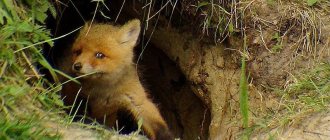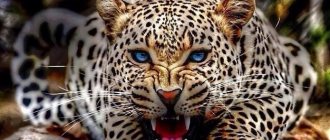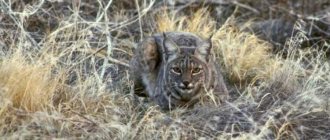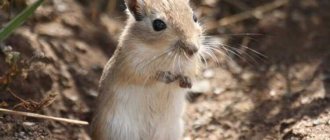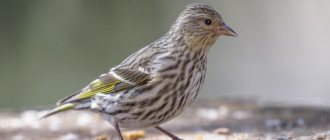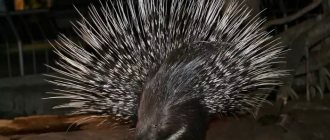- Common fox
- Korsak
- Afghan fox
- African fox
- Bengal fox or Indian fox
- fennec
- Paraguayan fox
- Gray or tree fox
The fox is without any doubt the most interesting animal on our planet. How many stories, fables and fairy tales do we know about this fiery red beauty? What makes her so popular is not only her beauty, but also her unique character, intelligence and savvy. The wild fox has caused a lot of trouble for agriculture with its thievery; it is especially attracted to poultry. However, in addition to the red fox, so well known to all of us, there are more than 40 species in the world, varying in size and color of fur. All of them are united by the canine family, and have characteristics characteristic of them. Occupying different continents, all species are united by basic similarities, way of life, way of feeding and reproduction.
Common fox
The brightest of the foxes. The red fox can be found throughout Eurasia and North America, it is difficult to say where they do not live, this is all its home. Its phenotype is characterized by a strong body structure, large size, good health, and a playful temperament. Animals of this type have thick, lush and silky hair of the same length throughout the body. The chest is light or yellowish, the belly is white or reddish (as are the sides), or with a black spot on a red background. The ears and toes of the paws are black. The tip of the tail is usually white, but black hair is scattered along the entire length, and not rarely over the body. The down all over the body is gray or brown in various shades. The backbone and sides of the animal are bright red in color, which can be of various shades. The red fox is the largest species of the fox genus. The length of its body reaches 90 cm, tail -60 cm, weight from 6 to 10 kg.
The fox is the most typical predator that knows no pity for the object of its hunt. Its usual diet consists of rodents and insects, but it is not averse to eating hares, bird eggs, and even the bird itself. Jumping high like a cat, it will not be difficult for her to catch it.
Plant foods, such as fruits, berries or fruits, although they do not play a role in feeding the fox, are nevertheless included in its diet.
Foxes breed only once a year. The female's pregnancy lasts from 7 to 9 weeks. In a litter, from 4 to 12 puppies are born, colored dark brown. Outwardly, they can easily be confused with wolf cubs if you do not see the white tip of the tail. After 14 days, the fox cubs can already see and hear, and can already boast of sharp teeth. Foxes cannot be called bad parents; both mother and father take care of the offspring. However, the constant absence of parents in search of prey leads to the early development of the offspring, and after 1.5 months of life, fox cubs can gradually develop new territory and eat adult food. After half a year, they are considered fully grown and can live independently.
In Alaska, there is a mutation of the Canadian red breed - the black and brown fox. Currently, various breeds of foxes are known in fur farming, characterized by the type of coloration of animals bred by humans in captivity to obtain fur, which are the result of crossing the red fox and the silver fox.
Lifestyle and habits
Prefers to live in open areas adjacent to forests. To live, foxes dig holes where they can either hide from surveillance or wait out inclement weather. A fox's hole is a complex-shaped structure consisting of many labyrinths. Moreover, with each subsequent generation, the foxes only complicate and complement the design of the labyrinth.
Foxes are solitary hunters, but to create a family they unite in pairs.
Foxes living alone survive due to their high endurance and cunning, which lies in the basic habits of the fox - the ability to confuse its pursuer or prey. They also have fast legs to their aid - the speed of a fox can exceed 10 km/h.
Footprints
The peculiarity of the movement of any fox is that it never follows a straight path. This is caused by the character of the fox, or rather its simple curiosity - every corner on the way must be explored. In addition, this helps her evade pursuit much faster.
Fox tracks can be confused with dog tracks. But if you look closely, you can see that they will be slimmer, and their claws will leave a clearer imprint. Step length is about 25-30 cm.
If a fox moved through shallow snow in winter, then the location of the fox's tracks will be stretched out in one line - as if under a ruler.
Korsak
Korsak, the second representative of the fox family. In appearance it resembles a red wild fox, but is smaller in size with large ears and long paws. With wide cheekbones and small triangular-shaped ears, the corsac's muzzle is short and pointed. The fur of this fox is light gray and reddish-gray. But, there are individuals with an element of red on their fur coat. The belly is white or slightly yellowish, and the chin is light. The tail tassel is dark brown or completely black. In winter, you can observe the appearance of a gray coating near the ridge of the animal. The length of hair in animals is also subject to seasonal changes. In winter, he exchanges his short summer coat for longer and heavily pubescent fur. It is a colonizing species of the southern and eastern parts of Europe and Asia. They inhabit steppes and deserts with little vegetation. The corsac avoids dense thickets, which is why it is also called the steppe fox. As a home, it uses ready-made badger holes, holes of marmots, gerbils or other foxes.
Corsac fish usually hunt at night. The main diet consists of rodents, reptiles, insects or birds, which is what competes with the common fox. If there is a shortage of food, it will not disdain carrion or various garbage. They are not attracted to plant food. At the sight of a person, the corsac exhibits fox-like cunning; it often pretends to be dead, and runs away at the first opportunity. Interestingly, representatives of this species are apparently monogamous, which is not typical for the common fox. As for the rest, as far as reproduction and nutrition of puppies are concerned, they are almost similar. The female bears from 2 to 11 puppies (rarely 16) within 2 months. From the second week, the offspring show their first activity, they begin to see and hear. After 5 months they leave their home.
Korsak is listed in the Red Book.
Genus Urocyon
Two species in North America.
Gray fox ( Urocyon cinereoargenteus)
Placed in the genus Urocyon in part because of its longer tail, which allows it to climb trees. Distributed from the center of the USA to the prairies, from the south to Venezuela, from the north to Ontario. Dimensions: DT 52-69 cm; DH 27-45 cm; M 2.5-7 kg.
Description: fangs are shorter than those of Vulpes; color gray with streaks; throat white; paws are reddish-brown; a ridge of stiff black hairs along the dorsal surface of the tail.
Island fox (Urocyon littoralis)
Distribution: islands in the western United States. Dimensions: DT 59-79 cm; DH 11-29 cm; M 1.1-2.7 kg.
Description: Smaller than the gray fox, but otherwise identical.
Conservation status: quite numerous, depends on general measures for nature conservation.
Afghan fox
This fox is also a representative of the fox genus. Lives in the Middle East up to Afghanistan. The Afghan fox is not afraid of hot climates; it can be found both in the mountains and in the driest areas, for example in the Dead Sea. This representative of the fox family cannot boast of large size and bright color, but her long tail with thick fur is equal in length to her body, and attracts attention to her external appearance. The height of foxes does not exceed 30 cm, and the body length ranges from 45 to 55 cm, with a weight of 1.5-3 kg.
The animal has a small graceful head with a short and pointed muzzle, on which a black stripe extends symmetrically from the eyes to the upper lip. Nature, having awarded this fox with large ears, which serve not only as an organ of hearing, but also as a heat sink in hot weather, deprived it of the protective thick layer of hair that covers the paw pads of all types of desert foxes, protecting it from the hot sand.
In summer, the fox's fur is covered in an unremarkable steel color with a lightish stripe on the throat and belly. Depending on where they live, animals can be light brown or almost black. And in winter, the coat of the Afghan fox is colored rusty-brown, with a gray underfur and black guard hairs. It looks very velvety and lush. The diet of the Afghan fox is quite different from other species. In addition to insects and rodents, plant food plays an important role in her life. In “love” these foxes are fickle, and form a pair only during the mating season. The female plays a major role in caring for the offspring. The male can only perform the security function of the den. The pregnancy of a fox lasts about 2 months; compared to the common fox and even the corsac fox, which does not differ in size, the Afghan fox has low fertility. 1-3 cubs are born, rarely three.
This species is also listed in the Red Book.
Economic importance
From the point of view of economic importance, the description of a fox can be both negative and positive. If we look at them as pests, their contribution to the destruction of domestic sheep and lambs is obvious. In addition, they contribute to the spread of dangerous parasites, such as ticks, to other animal species with which humans can come into contact.
The benefit of foxes also lies in their passion for exterminating other species. For example, information about the fox says that this species annually saves entire fields by destroying harmful rodents such as voles. Also, helping forestry is a plus, because the fox’s diet also includes some types of harmful insects that can cause serious damage to young tree plantations.
African fox
They are inhabitants of dry, sandy, siliceous desert types stretching from Africa to the Sahara. African foxes lead a rather hidden life. From the known facts of the existence of this species, we can say that these are rather small representatives of foxes: body size 38 -45 cm, a small tail up to 30 cm and height at the withers up to 25 cm, weight from 1.5 to 3.6 kg. The body color can be light red or brown, the tail is darker with a black tip. The back along the entire length in the center is painted with a dark stripe. The belly, muzzle and outer sides of the ears are white. The eyes of older individuals are framed with black edging. It is interesting that representatives of this genus of foxes have scent glands at the base of their tail. The African fox's diet is similar to other foxes.
A feature of their way of life is the presence of so-called family groups, which consist of the main couple, a single male and growing young foxes that have not yet reached maturity. The breeding season of the African fox is unknown. Pregnancy in a female proceeds faster and lasts almost one and a half months. The offspring number from 3 to 6 children, in whose upbringing all members of their social group take part.
Interesting Facts
A cunning character and beautiful fur are not the only reasons to pay attention to foxes.
There are interesting facts about foxes that will allow you to look at these animals in a new way:
- Despite their direct relationship with dogs, they have many similarities with representatives of the cat family. These include a predominantly nocturnal lifestyle, as well as claws that can extend.
- Like turtles and sharks, these red predators can sense the Earth's magnetic field. They use it as a natural compass, oriented to the north in the dark, which makes night hunting much easier.
- You may also find it interesting how long foxes live in captivity. On average, the life expectancy of foxes in captivity can be much longer than in the wild. Domesticated individuals sometimes live up to their 25th birthday, while free individuals may not live even three years due to disease and hunger.
Bengal fox or Indian fox
This is a moderately built animal. The length of the body reaches 45-60 cm. The tail is half the length of the body, the height of the fox varies up to 28 cm. The brown color of the fur can be of various shades: from light to red. But the tip of the tail always remains black. Inhabits the foothills of the Southern Himalayas, Nepal, Bangladesh and India. Avoids dense vegetation, but the bare desert is not to its taste either. The Bengal fox feels good in sparsely populated forests, fields and mountains.
This fox also does not adhere to a diet; floral food is a rare occurrence in its diet. The objects of its hunt are insects, arthropods, reptiles, birds, eggs and rodents. Bengal foxes are monogamous. Females whelp 2-5 puppies after a month and a half of pregnancy.
Nutrition
Depending on the time of year and location, the list of what foxes eat may change. These are mainly small rodents, hares and birds. Sometimes red predators feed on found carrion.
What does a fox eat if the hunt was unsuccessful? The redhead switches to a plant-based diet; she is helped out by berries and fruits growing in the forests, as well as the green parts of some plants.
It is part of their habits not to hunt near the place where foxes live. The hunting technique contains many features that help a fox hunt alone. To do this, stalking, sudden changes in running direction and unexpected throws at the victim are actively used.
fennec
It is a desert native extending from Morocco to Tunisia, Egypt to Somalia. Fennec fox is the tiniest fox with an unusual appearance. This animal is the size of a pet
cat. At the withers, the fennec reaches 18-22 cm, the body length is on average 30 cm, and the animal weighs one and a half kilograms. The muzzle is short and sharp. Fenech attracts a lot of attention with its ears. He is the owner of the largest ears, disproportionate to the head, among predators. Their length reaches almost half of the animal’s body. However, such an inharmonious build of the fennec is due to its habitat. The ears, as well as the furry feet, characteristic of all steppe foxes, serve them for cooling.
The fennec cat's fur is thick, silky and long. Its upper part is red or fawn, and its lower part is white. The tail is quite pubescent, with a black tip. In the wild habitat it digs a deep hole with numerous tunnels, in the vicinity of bushes and grass thickets. Fenech does not like loneliness; family groups consist of 10 individuals. The members of such a family are usually usually a “married” couple and children from the previous litter who have not reached puberty. The chanterelle's food consists of small vertebrates, eggs, insects, carrion, plant rhizomes and fruits.
When catching food, they show agility, agility, mobility and the ability to jump high and far, up to 70 centimeters in height.
Fennec breeding occurs once a year. Puppies are born after 50-53 days.
The female does not leave the den until they are two weeks old, and does not allow the male to approach them. After 3 months of life, babies can already leave their mother.
The little fennec can also be found at home as a pet. Fans of exotic animals are ready to pay a considerable amount for a pretty fennec. Domestic phoenixes are very inquisitive, affectionate and funny animals.
Reproduction
The mating season is the time when loners by nature, as foxes are all other times, unite to raise their growing offspring. This period usually ends in February, after which the male begins to actively care for the female, to the point that she gets the prey after the hunt.
Also, before the birth of the fox cubs, the couple prepares a separate place - they dig a hole, most often with deep passages and a couple of emergency escape routes in case of danger. The fox whelps in a hole, where the little fox cubs spend the first days of their lives.
Pregnancy lasts 1.5-2 months. Usually the female brings 4-6 cubs. The father of the family supports the fox with her cubs until all the babies grow up and are ready for independent life.
As part of this preparation, adult foxes bring still-living prey into the hole and introduce the younger generation to what foxes eat and what hunting techniques should be used.
Paraguayan fox
This is one of the representatives of the genus of South American foxes, an inhabitant of the steppes of South America. It has quite large dimensions: height 40 cm, body length 65 cm, weight from 4 to 6.5 kg. The fox's back is reddish to black, with dark stripes down the middle. The top and sides of the head are red, the bottom of the head and white. The animal's ears are triangular in shape and red with white hair inside. The back, shoulders and sides of the street are gray. The hind legs are gray, on the sides with black spots below. The sides of the forelimbs are red. This fox was lucky in the variety of food on the continent. In addition to the main diet: rodents, insects, birds, the Paraguayan fox can feast on snails, scorpions, fish, crabs, possums or armadillos. Pregnancy in the species lasts almost two months. The offspring number from 3 to 6 cubs, which are looked after by both parents. At 2 months they are considered fully grown.
Keeping at home
Recently, people have increasingly begun to keep foxes as pets.
The domestication of these animals began in the mid-20th century. Breeders have developed new breeds, but the animal's instincts remain the same. When purchasing a fox for a home, it is important to be very careful and not be lazy in raising it correctly, because otherwise it can not only harm the household, but also destroy other pets or destroy the home.
As a rule, when in the house, trained females and males behave quite good-naturedly and obediently. They play with pleasure with their owner and pets, and easily learn various tricks.
The animal must be provided with special conditions
It is important to brush and bathe him regularly. Domestic foxes sleep in enclosures or on spacious bedding
Walking on the street is only possible on a leash.
Nutrition should be as close as possible to the diet in the wild. The basis of the menu should be meat, boiled or steamed, but not raw. The animal will not refuse fruits and vegetables, insects, and raw eggs. Feeding offal is encouraged. To prevent digestive problems, bones and unpeeled raw fish should not be given to the fox.
If desired, you can feed the animals food intended for dogs. However, even in this case, the fox must periodically receive vegetables, meat and other protein foods.
Marble mutations
There are many white mutations within the merle species. Foxes of this color were created on the basis of individuals with black-silver or red color. White color is dominant, but there are colored spots on the coat. Breeders have bred the following types of domestic white foxes:
- white marble: black spots on the back of the ears, dark edging along the edge of the ears; eye color depends on the color of the individuals that participated in mating; when crossed with cream-colored animals, the puppies have blue eyes and a pink nose; the offspring from the silver fox are distinguished by black eyes and nose;
- Atom; the breed appeared by crossing individuals of the white and arctic marble species; animals have a black stripe along their back, edging on their ears, and a dark crown on their head;
- sanglo; The exterior of foxes is similar to Atom, but instead of black, the fur has a red tint.
When breeding domestic foxes, pay attention to the white color gene. Most often it is lethal
Individuals of the same color are not suitable for mating. It is recommended to choose animals with different mutations. Otherwise, the fox will bring dead puppies.
Skilled builders
These animals usually live in burrows. Foxes are skilled builders and dig complex burrows with several additional exits (burrows). Foxes use these exits to escape when other animals (hunting dogs) enter the hole or when the hole is flooded during a flood, for example. However, foxes are happy to occupy suitable burrows of other animals. Thus, a large red fox often inhabits badger holes, and does this even when there is an owner in the hole! The badger is famous for its cleanliness; it cannot stand the fox smell and food debris scattered near the hole, so it leaves its home and digs a new hole. Thus, the fox becomes the owner of a comfortable home.
Night hunters
Foxes that live in deserts and steppes usually go hunting at night, waiting out the heat of the day in a hole. In cooler regions, these animals can often be seen during the day. Foxes are both cautious and curious. On the one hand, they are sensitive to suspicious sounds and smells (both their hearing and sense of smell are excellent), on the other hand, they often hunt in the presence of humans, approaching homes and roads. These animals move by jogging or mincing steps, but in case of danger they are able to run quickly. Red foxes are quite hardy and can withstand being pursued by hunters for a couple of hours. Despite their external resemblance to wolves, foxes are able to... climb trees. Of course, not all species do this, but those that live in forests. Even the common red fox can climb shallow tree branches, and gray foxes from North America simply spend a significant portion of their time there. For this they are also called tree foxes. Such abilities indicate kinship with cats.
Foxes, even of large species, prefer to hunt small rodents and only in case of a shortage of this food do they turn their attention to other animals. On occasion, they catch hares, marmots, various birds, frogs, pick up dead fish and other carrion, sometimes foxes even manage to catch a hedgehog
In summer they can eat herbaceous plants and berries. Only the smallest desert species (fennec fox, bat-eared fox) specialize in feeding on insects, but they are also capable of catching a small lizard or destroying a bird’s nest. Foxes do not attack poultry as often as is commonly thought. The method of obtaining food in these animals is intermediate between the hunting style of wolves and wild cats. On the one hand, foxes never hide and approach their prey almost openly; on the other hand, although they try to chase the victim, they are not capable of long-term pursuit. When hunting rodents, the fox usually listens, thanks to its very fine hearing, determines the position of the prey with an accuracy of a centimeter, and then overtakes it with a deft leap. Moreover, the fox is able to determine the exact location of a mouse or vole even under the snow, without seeing it.
Foxes reproduce once a year. The rut occurs in December-March. At this time, several suitors may be around one female. If the forces are equal and none of them wants to give in voluntarily, the males get involved in a fight.
Light colors
The more different the shade of a fox's fur is, the less natural instincts it exhibits. Animals of light color do not have increased immunity
However, they always attract the attention of keepers. The following breeds are in demand:
- arctic marble; white fur, the animal has black spots on its forehead; eyes and ears have a dark rim; there is a black stripe along the back;
- sanglo; red marble; In color, the individuals are similar to arctic marbled animals, but all the markings on the face and back are red;
- snowy Bakuriantskaya; The animal's body and tail are white, there are black spots on the face, the ears are dark, and there is a black belt on the back;
- snow red; there are red and black spots on the snow-white fur; they can connect to form a pattern;
- white marble; white fur over the entire surface of the body; eyes and nose are black; The fox's puppies are light colored.
There are colors that are included in the “fire and ice” group. The animals are light-colored, but always have a bright contrasting color on their paws, tail or head. The “fire factor” shade is distinguished by the black color of the limbs and the burgundy tint of the guard tips.
Snow fox
“Autumn Fire” has a similar color, but all shades are golden. When purchasing a fox for home keeping, it is recommended to ask the breeder about the pet’s parents. If individuals of the pearl mutation were involved in mating, then you must be prepared for certain difficulties. Caring for a fox is never easy.
